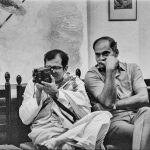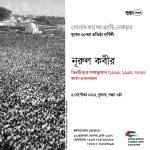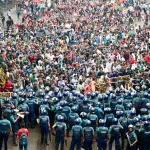The Photography of Sunil Janah
By?MALAVIKA VYAWAHARE
Photographer?Sunil Janah, who died on June 21 at age 94, was, like Margaret Bourke-White, a ?faithful servant of history,? Vicki Goldberg said in a 1998?review?in The New York Times of an exhibition in Manhattan that featured hundreds of his photographs, and a few from both.
While Ms. Bourke-White?s ?bold, static, iconic images were an effective form of shorthand to sum up major events in a photo essay for a public that knew little of the place or people,? she wrote, Mr. Janah?s style ?tended to be looser, somewhat more caught on the wing and intimate.?
Mr. Janah?s documentary photography spans decades, and includes some of the only remaining pictorial coverage of major news events.
?Mr. Janah photographed lines of emaciated people waiting for food, groups of skeletons, hungry dogs gnawing at human bones,? during the Bengal famine in 1942, Ms. Goldberg wrote. He documented murderous riots that broke out between Hindus and Muslims in 1946, photographing bloated bodies lying in the street, and the aftermath: a barbed-wire fence separating the Hindu and Muslim quarters. Later, he became disgusted with politics and turned to portraits and other subjects.
?He visually documented the ethnography of the country in a way that nobody had really done before. He went from one remote corner of the country to another,? his son, Arjun Janah, said in an interview to?Kamla Bhatt.
In a 1998 interview with?Frontline, the elder Mr. Janah recounted how P.C. Joshi, general secretary of the Communist Party of India, called and asked him to accompany him on his trip to report on the Bengal Famine in 1942. ??I shall do the reportage and you take the photographs is what he told me,? Mr. Janah said, ?and that is how I became a photographer.?
Describing his work on the Bengal famine, which was reprinted on postcards sent across the world to raise funds, Mr. Janah said:
?It was very distressing because I felt like doing things other than taking photographs. The camera is, of course, a kind of symbol of prying curiosity. People were starving and dying and I was holding a camera to their faces, intruding into their suffering and grief. I envied people who were involved in relief work because they were at least doing something to relieve the people?s distress. It was a very harrowing experience, but I also felt that I had to take photographs. There had to be a record of what was happening, and I would do it with my photographs.?
Mr. Joshi persuaded Mr. Janah to forgo the postgraduate degree in English he was pursuing in Calcutta (now Kolkata) and join the Communist Party of India at it?s Mumbai office.
Later in life he was sought out by Ms. Bourke-White, a photographer with Life magazine who brought images from India?s independence movement to American homes.
?There was something about the quality of his photographs that spoke to everybody, whether it was famous photographers like Bourke-White?and Henri Cartier-Bresson or ordinary folk,? Arjun Janah said of his father?s photography. ?Many of his pictures were tightly composed, much like a pithy poem. They had a quality that caught your eye.?
Despite possessing skills and a body of work that would be the envy of any photographer, Mr. Janah was reticent to open up to writers interested in penning books on him, or to mount exhibitions of his work in India.
Close friend and fellow photographer Ram Rahman, in an interview with?The Hindu?after Mr. Janah?s death, attributed this reclusiveness to his anger at people who were using his work without his consent. ?He had become suspicious of people evincing interest in his work.?
Sunil Janah?s work can be viewed on?Web site?which is managed by his son Arjun. ?Photographing India,? a book of Mr. Janah?s photographs taken between 1942 and 1978 is being published by Oxford University Press this year.













Leave a Reply
You must be logged in to post a comment.